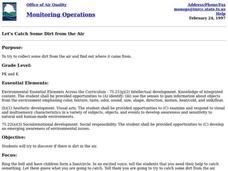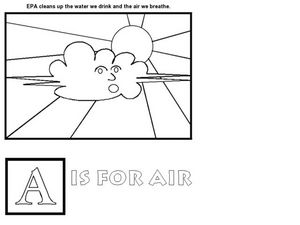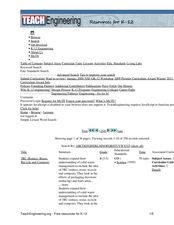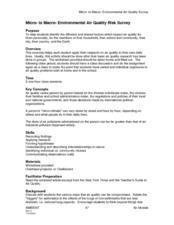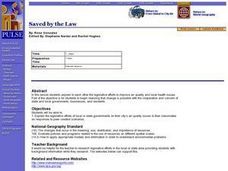Curated OER
Heat, Wind and Storms Affect Air Quality
Students study heat and wind's affect on air quality. For this air quality lesson, students locate an article about air pollution. Students research a solution for the air pollution problem and use a model from nature to help them solve...
Curated OER
Is It Breathable?
Students explore air quality. In this environmental lesson, students observe a simulation of air pollution by blowing into a jar (with a straw) that has chalk dust. Students discuss how air quality can effect the way we breathe.
Curated OER
Air Quality and Transportation in the Tulsa Area
Students investigate the effects of air pollution. In this environmental lesson, students discuss the causes of air pollution and identify how transportation has an effect on the air quality. Students identify other alternatives to driving.
Curated OER
Let's Catch Some Dirt From the Air
Learners investigate the dirt in the air. In this air quality lesson, students use aluminum foil and petroleum jelly to discover if there is dirt in the air. Learners discuss results.
Curated OER
A is for Air
In this air pollution worksheet, students read the phrase 'EPA cleans up the water we drink and the air we breathe, and 'A is for Air.' Students then color the picture of the sky, cloud, and sun.
Curated OER
Got Dirty Air?
Students study air pollution and its effect on air quality. In this environmental science and engineering lesson, students watch a demonstration of incomplete combustion as it contributes to air pollution, study the importance of air,...
Curated OER
Consider The Source
Students learn about the largest natural and human sources of air pollution to become aware of these components in their surrounding environment. In this environmental lesson, students read and describe natural sources of air pollution....
Curated OER
The Awful Eight
Students investigate the concept of a carpool and its contributions to either reducing or increasing air pollution. They conduct research using a variety of resources for background information. The information is used to write a play...
Curated OER
Effects of Acid Rain
Third graders explore the concept of acid rain and its effects on ecosystems. They are placed in groups and using a graphic organizer they brainstorm their ideas about what would happen to the ecosystems living within these environments...
Curated OER
Critical Reading- Air Pollution and Asthma
Students read two different articles which present the scientific issue of asthma, the causes, and the rising rates in our society. Students read for facts and examine whether or not the scientists have a political point of view....
Curated OER
Micro- To Macro- Environmental Air Quality Risk Survey
High schoolers research the importance of air quality. In groups, students explore factors leading to poor air quality and methods of minimizing air pollution. Given a diagram of concentric circles, high schoolers survey their personal...
Curated OER
Saved by the Law
Students explain the legislative efforts of local or state governments on their city's air quality issues to their classmates as responses to peer-created scenarios. They determine that change is possible with the cooperation and...
Curated OER
What's the Connection Between Convection and Inversion?
Ninth graders observe a simulation demonstrating the difference between convection and inversion. They explain where and when convection and inversion layers occur and how each impacts air quality, and by connection, human health.
Curated OER
It's Up In the Air
Students examine a variety of tools that are used to collect scientific data. They conduct an experiment that reveals what type of particles is in the air at their school. Students report on their findings.
Curated OER
Moving without Wheels
Learners observe a simple water cycle model to better understand its role in pollutant transport. This activity shows one way in which pollution is affected by the water cycle; it simulates a point source of pollution in a lake and the...
Curated OER
Let's Bag It
Students observe and discuss a vacuum cleaner model of a baghouse to better understand how this pollutant recovery method functions in cleaning industrial air pollution. They give examples of when the use of a baghouse is appropriate,...
Curated OER
For Your Eyes Only
Students identify two major types of visible pollutants, smog, and particulate matter, They explain that air pollutants are generated during incomplete combustion. They measure and rank collectors from the most pollutants to the least...
Curated OER
The Search for Secret Agents
Students embark on a scavenger hunt around the school looking for indoor air pollution and mapping source locations. They predict and observe sources of indoor air pollution, understand and give examples of technologies we use related to...
Curated OER
Cleaning the Air
Students investigate how engineers design methods of removing particulate matter from industrial sources to minimize negative effects of air pollution. In small groups they design and construct a filter with the goal of removing pepper...
Curated OER
Indoor Air: What's the Matter?
Young scholars investigate the variety and amount of particulate matter in the air. They locate the general sources of pollution for a specific area and develop some suggestions for improving air quality.
Curated OER
The No Zone of Ozone
Young scholars explore the causes and effects of the Earth's ozone holes through discussion and an interactive simulation. Using gumdrops and toothpicks, they conduct a large-group, interactive ozone depletion model.
Curated OER
Air Terms: The Flash Card Game
Fifth graders define vocabulary words regarding air quality. In small groups, they match magazine pictures or create illustrations for definitions and terms, and share the flash cards with their group.
Curated OER
The Awful 8: A Play
Students perform a play that presents the causes and effects on people and the environment of the eight major air pollutants.
Curated OER
Air Pollution Baseball
Students participate in a baseball game in which they answer questions related to air pollution. They answer true and false questions as well. They discuss the impact of air pollution on the environment.





